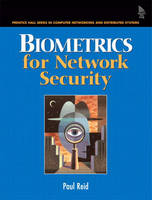
Biometrics for Network Security
Prentice Hall (Verlag)
978-0-13-101549-4 (ISBN)
- Titel ist leider vergriffen;
keine Neuauflage - Artikel merken
A guide to integrating biometrics in the process of network security. Covers: finger, iris, retina, voice and fac biometrics. Emphasis on how to quantify the strength of a particular biometric. Complete with guidelines for deployment in a large enterprise, one of author's clients is Citibank and they are about to start using biometrics in their network authentication system around the world.
PAUL REID is Senior Product Manager for CryptoMetrics in New York, where he specializes in real-world application, implementation, and design of biometric systems. CryptoMetrics is a security software solution provider, building and integrating secure trustworthy applications using the most advanced technology in cryptography and biometrics. Paul has worked globally for many Fortune 500 companies and is a frequent presenter at conferences.
Foreword.
Preface.
Acknowledgments.
I. INTRODUCTION AND BACKGROUND.
1. Introduction.
What Makes This Book Different? The Structure of This Book. Everything You Need to Know about Biometrics to Understand the First Three Chapters. Who Should Read This Book? Conclusion.
2. Authentication Technologies.
Something You Know. Something You Have. Something You Are. The Need for Strong Authentication. The role of Strong Authentication with Single Sign-On (SSO). Biometric Technologies: An Intelligent Solution. Conclusion.
3. Protecting Privacy with Biometrics and Policy.
Employer's Right to Privacy. Employee's Right to Privacy. Conclusion.
II. BIOMETRIC TECHNOLOGIES.
4. Biometric Technologies.
User Interaction with Biometric Technology. What Makes a Good Biometric? What Makes a Good Biometric for Network Security? Conclusion.
5. Finger Biometric Technologies.
General Description of Fingerprints. How Is the Finger Imaged? Types of Algorithms Used for Interpretation. How Can this Biometric be Spoofed? Conclusion.
6. Face Biometric Technologies.
General Description of Face Biometrics. How Is the Face Imaged? What Types of Algorithms Are Used for Facial Interpretation? How Can This Biometric Be Spoofed? Conclusion.
7. Voice Biometric Technologies.
General Description of Voice Biometrics. How Is the Voice Captured? Types of Algorithms Used for Voice Interpretation. How Can This Biometric Be Spoofed? Conclusion.
8. Iris Biometric Technology.
General Description of Iris Biometrics. How Is the Iris Captured? Description of the Iris Algorithm. How Can This Biometric Be Spoofed? Conclusion.
III. IMPLEMENTING BIOMETRICS FOR NETWORK SECURITY.
9. Recommended Biometric for Network Security.
Finger Biometrics. Face Biometrics. Voice Biometrics. Iris Biometrics. The Choice of a Biometric for Network Access. Conclusion.
10. An Introduction to Statistical Measures of Biometrics.
FAR. FRR. FTE. EER. What Measure Is Most Important? Conclusion.
11. The Biometric Transaction.
Securing and Trusting a Biometric Transaction. Matching Location. Conclusion.
12. Preparing for the Proof of Concept and Selecting a Vendor.
Define the Driver of the Project as Either Corporate IT or a Business Need. Define the Business Need or Objectives. Designate the Internal Sponsor of the Project. Define the Stakeholders. Define a Clear Set of Goals and Success Criteria for the Project. Form and Charter the POC Group. Based on the Goals and Success Criteria, Invite a Few Vendors to Pilot. Set the Timelines for the POC and Ensure That the Implementation Activities Are Done Within the Scope of the POC. Deploy the POC. Monitor and Evaluate the POC. Wrap Up the POC. Decide on the Validity of Each Vendor's Solution. Make a Go/No Go Decision to Move Ahead. Announce the Results and Lay the Groundwork for the Next Phase. Conclusion.
13. Preparing for the Pilot Deployment.
Define the Group of Stakeholders. Put in Place a Project Management Team That Can See the Solution Through to Rollout. Form and Charter the Pilot Group. Develop Policy Documents. Summarize Daily Reports Weekly and Send Them Out. Address and Track Problems and Solutions As They Happen. Put a Training Plan in Place. Prepare Audit and Analysis Reports. Build and Test an Automated Install. Roll Out the Software and Hardware in a Practical Manner. Provide Mechanisms for Feedback. After Initial Pilot Rollout, Get the Executives Involved. Start Addressing Issues of Scalability and Manageability for Rollout. Near the End of the Pilot, Start Discussing the Next Steps. Wrap Up the Pilot. Make a Go/No Go Decision. Build a Transition Book. Conclusion.
14. Preparing for the Rollout.
Why Is This Chapter So Short? Conclusion.
IV. FUTURE AND CONCLUSIONS.
15. The Future of Biometric Authentication.
Will Biometrics Be Integrated Everywhere? What Other Biometric Measures Will Exist? A Futuristic Example: New Form of “Caller ID”. Conclusion.
Glossary.
Bibliography.
Index.
| Erscheint lt. Verlag | 15.1.2004 |
|---|---|
| Verlagsort | Upper Saddle River |
| Sprache | englisch |
| Maße | 177 x 234 mm |
| Gewicht | 549 g |
| Themenwelt | Informatik ► Theorie / Studium ► Kryptologie |
| Informatik ► Theorie / Studium ► Künstliche Intelligenz / Robotik | |
| ISBN-10 | 0-13-101549-4 / 0131015494 |
| ISBN-13 | 978-0-13-101549-4 / 9780131015494 |
| Zustand | Neuware |
| Haben Sie eine Frage zum Produkt? |
aus dem Bereich


